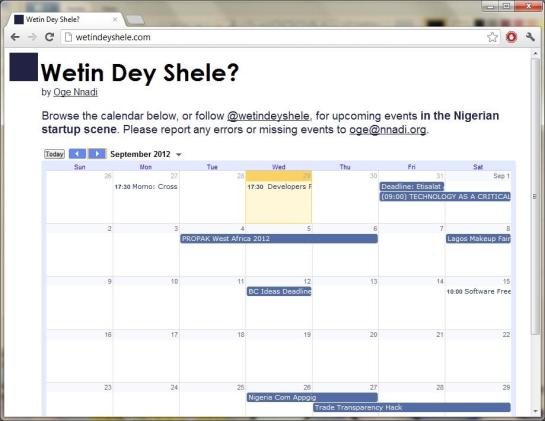Happy middle of the month everyone! Tomorrow is Software Freedom Day. I talked about it in last week’s post so I won’t talk about it this week. The image above is called Programmers and Women. As you can see, the woman is … and the programmer is clearly unaware. But it isn’t just women. The dark side of programming is that programmers can easily lose themselves in their work and lose their grip on “normal” life.
This week we will be featuring the first guest writer on this blog. In the spirit of Software Freedom Day, I talking about wetindeyshele.com. I personally believe in products that are creative and innovative. In terms of Technology Wizardry, do I find wetindeyshele.com technically complex? The answer is no! But is it useful and does it have great market potential? The answer is yes! I will stop talking and let Oge Nnadi do the rest …
Summary
I made the entrepreneurial events calendar, using open source and free services and software including Google Calendar, Google Analytics, Heroku, and Git.
I’ve always been a fan of open source and free software. I subscribe mostly to the tenets of free software foundation, and during my undergraduate computer science courses, I was trained on open source tools. So when I decided to create a public calendar to track all the tech and startup events happening around me, I naturally turned to such tools.
Google Calendar
Wetindeyshele is a single Web page showing a calendar with upcoming and past startup-related events; the arrows near the top let a user browse through different months. This calendar was made with Google Calendar and simply embedded in the page. The instructions for embedding a Google calendar on your site are straightforward, but be sure to test the embed when you are logged out of your Google account so you confirm that others will be able to see the calendar as well.
Google Analytics
In order to track the number of visitors Wetindeyshele gets, I placed a block of Google Analytics tracking JavaScript code into the page.
This code will differ based on the site you’re tracking for. Adding it let’s me see information about the site’s visitors like what country they’re from, what site referred them, how long they spent on the site etc.
Git and Heroku
I like to track the changes I’ve made to all the software I write over time; it helps me easily roll back mistakes I make. My revision-control software of choice is Git and I prefer it over others such as Subversion because I can easily see the entire history of the project without running a server or having to be online.
One benefit of this choice is that it lets me easily deploy my code to my Web host, Heroku. I use Heroku for two reasons: 1) they provide a free hosting option for really small applications, and 2) they use Git as a transport mechanism for deployment so I don’t have to use, for instance, a separate FTP client to upload my site. In practice, this means that after I’ve made new changes to the site on my local machine, I can type
> git push heroku master
at the command line to immediately deploy the changes. It makes my life just a bit easier.
Conclusion
That’s it for the open source and free tools I used to create Wetindeyshele. For more complex sites where I need finer control of the software running on the server, I sometimes use the server operating system, Ubuntu Linux and run my own Apache Web server. But that’s an article for another day.
About the author
Oge Nnadi likes to teach Web development, create algorithms, and watch anime.



